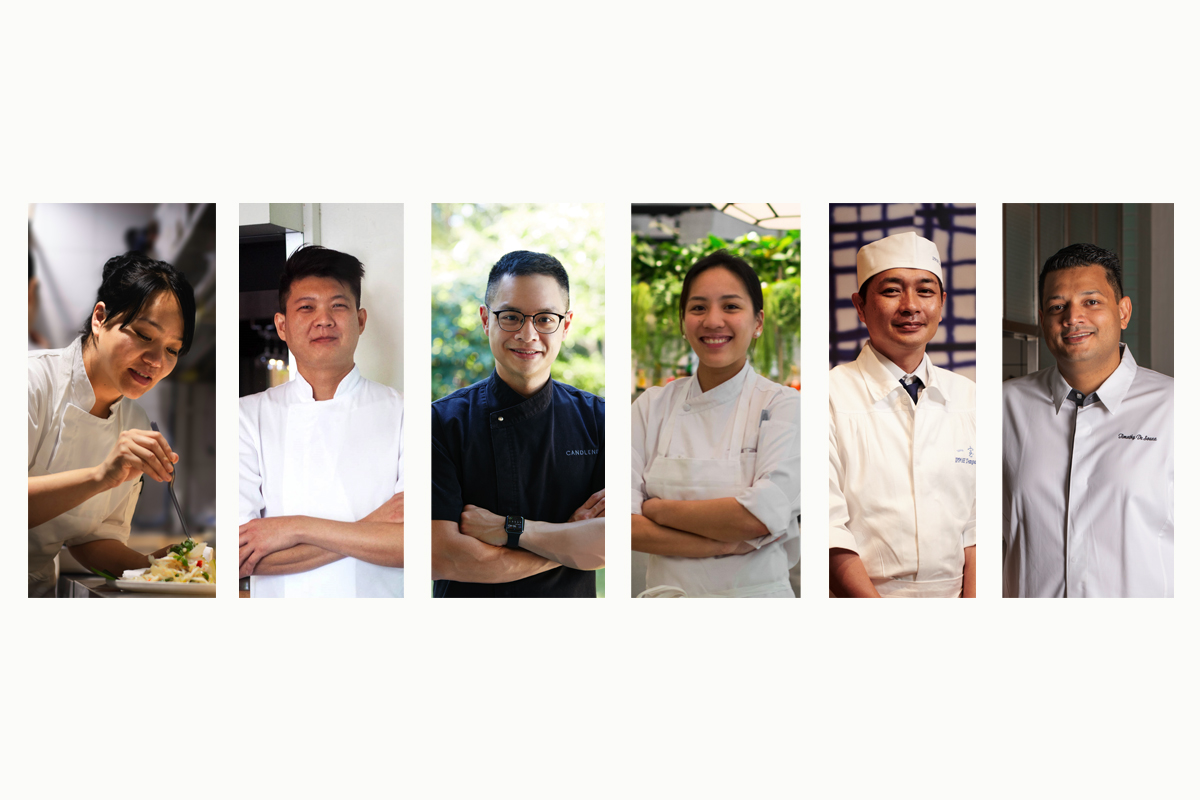A Day in the Life Of…
What does it take to helm a professional kitchen? What happens when a global pandemic strikes? To commemorate International Chef Day (Oct 20th), we asked our Executive and Head Chefs to share with us a day in their lives. Think mandatory cups of coffee, tirelessly ensuring the quality of the daily flow of events, and above all, an unbridled passion for food and service. Read on below and stay tuned for more explorations of the individuals behind your dining experiences on our social media @comodempsey.
Chef-Owner Malcolm Lee | Candlenut
Executive Chef Tshering Lhaden | COMO Cuisine
Executive Chef Timothy de Souza | Culina Bistro
Executive Chef Yamamura Katsuhiko | Ippoh Tempura Bar by Ginza Ippoh
Executive Chef Melissa Revilla | The Dempsey Cookhouse and Bar
Head Chef Ben Woo | The Pantry
A Day in the Life Of Chef-Owner Malcolm Lee
Candlenut
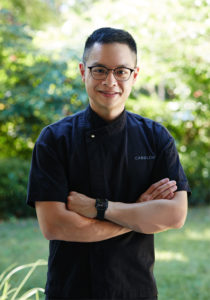
Take us through a typical day in your life.
The day starts pretty early for me. I try to squeeze in a short workout – a High Intensity Interval Training session or a swim – before I leave for the market by 8am or even 7.30am at times. A typical breakfast for me would be two eggs – sometimes scrambled, other times a sunny-side up. I like eggs because breakfast needs to be a quick and easy meal before I head out.
I’ll go to either Tekka Market or Tiong Bahru Market as they have a wide selection of local produce. Sometimes, I have to visit more than one market to get all the ingredients. Prep for service starts at about 10.30am and it’ll be a hectic rush till lunch service ends at around 2.30pm to 3pm.
During the break, I’ll either do interviews or research on new dishes. When dinner service ends at around 10.30pm, our work‘s not done for the day. We’ll have our kitchen briefing which can go on till 1am or 2am.
Once I get home, I’ll relax with some sparkling water. Sometimes I have a beer or gin and tonic if I don’t have to work the next day. I’ll catch up on IG and sometimes watch TV. I’m currently watching Little Nonya on Netflix.
What do you like to do on your day off?
I sometimes drop by the restaurant to check that everything’s going well. If not, I’ll be reading up to get inspiration for new dishes. I’m currently reading The Best of Singapore Cooking by Mrs Leong Yee Soo and Mrs Lee’s Cookbook by Mrs Lee Chin Koon.
When you’re in the restaurant, most of the time you don’t know what’s happening beyond the kitchen. So I enjoy taking long walks – sometimes along East Coast Park – just to see if there’s anything new or interesting.
Besides reading, what else inspires you?
My inspiration comes from many places – from what my mum cooks and what I eat at restaurants, to markets, books, staff meals and my travels.
Japan is one place that really inspires me in every aspect, from the produce to the presentation and service. The kaiseki restaurants there have a very different approach to food. They’re genuinely proud of their cuisine and culture, and pay deep respect to even the simplest of dishes like tofu or mochi.
A trip to Jakarta, Indonesia with renowned food critic KF Seetoh in 2015 sparked the idea for Candlenut’s Ahma-kase menu. I was introduced to an amazing array of satays. It wasn’t just about skewered meats, there were so many different styles and the flavours were mind-blowing. From snail satay to all parts of the pig imaginable on a stick, the choices were boundless. I was inspired by this to create a rotating menu of dishes that’s now known as the Taste of Candlenut.
I also made a trip to London in 2015 to sample the offerings from Michelin-starred restaurants there. We managed to cover 30 Michelin stars in 10 days. We were bursting at the seams from having tasting menus twice a day, every single day. We kept going on, fuelled by our hunger for knowledge and experience.
Conceptualising new dishes isn’t just about cooking. It’s a considered process that needs to be slowly refined into a concept – one that can be executed well by the team. It has always been my dream to have an R&D kitchen – a space to develop new concepts. It’s easier to get into the right headspace when you have a conducive place to research and experiment.
What did you miss the most before Phase Two started?
I missed the daily hustle and bustle in our dining space, working with the whole team and being able to have conversations with our guests. I also missed being able to go out freely – whether it’s for a swim or just to go buy something.
Once Phase Two started, I didn’t really have time as we had to be ready for dine-in. This meant rejigging our operations and having all the social distancing measures in place. Even though it’s been a busy period, I’m thankful that we can serve guests in our restaurant once again.
What would you be doing now if you were not a chef?
My childhood ambition was to be a bus driver or construction worker. I guess if I wasn’t a chef, I’d probably have signed on as a regular in the Army because I love Singapore and I enjoyed my time at the Guards Reconnaissance unit during National Service. Eventually, I may consider teaching – in the area of culinary arts – as I find that it offers the opportunity to help people grow.
Tell us something about yourself that’s not commonly known.
The minute I step into the restaurant, I have to take a double shot of espresso. Before service, I’ll have another double shot of espresso and again in the afternoon. At 6pm, if I feel like I need another boost I’ll down another double shot. Six shots is pretty normal on an average day.
A Day in the Life Of Executive Chef Tshering Lhaden
COMO Cuisine
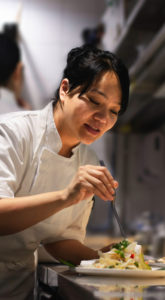
Take us through a typical day in your life.
I get up at 7am, and I usually head to the restaurant a bit earlier to ensure that it’s all set up and ready for customers. I like to start the day right by having a simple breakfast of toast and coffee to keep my energy up. For lunch, the different sections of the culinary team – from grill to pan to dessert – take turns to prepare the staff meals. The meals are always different and quite international as our team members are from all over. Some days it can be a simple biryani or steamed fish. Other times, it can be Thai dishes like Som Tum – a green papaya salad – and green curry.
Between service, I always make sure that the culinary team is following the correct recipes and methods, as well as check that the mise en place is well-organised so that we won’t run out of any ingredients in the middle of the service. I also take the chance to settle some paperwork and come up with new recipes.
As a chef, work only ends when the last customers are served their final dishes for the evening. This can sometimes be as late as 10pm. Spending time with friends or some quiet time alone at home comforts me the most after a long hard day at work.
Where are some of your favourite places to source for ingredients and why?
COMO Cuisine’s dishes are underpinned by freshness and quality. We get a fair bit of premium imported produce from Culina. We’ll also balance this with seasonal vegetables, fruits and seafood from local and sustainable sources. There aren’t any specific places I frequent. However, during my days off I’ll go around to different markets and if I find some good ingredients, I’ll inform our purchasing team about it.
What did you miss most before Phase 2 started?
There were plenty of things that I missed – from being in the kitchen all the time to meeting our guests and catching up with some of our regulars on a daily basis. It was definitely a challenging time for all of us and we certainly hope that this difficult time will pass. Meeting up with friends and dining out was also one of things I missed greatly back then.
What inspires you?
I get loads of inspiration when I brainstorm for new menu ideas with our COMO Hotels and Resorts’ Culinary Vice President Daniel Moran. It can be hard work to conceptualise new dishes but I find these sessions very insightful and valuable to keep the creative juices flowing. Cooking with an incredible team is always inspirational – it keeps me grounded and never fails to remind me why I love my job. Despite the long working hours and challenges, I’m always comforted and inspired when guests tell me that they had a great dining experience.
Tell us something about yourself that’s not commonly known.
I’m a huge dog lover!
I’m also a strong believer in the power of positive thinking. I start each day thinking about how I can deliver the best dining experience to each and every guest that steps into COMO Cuisine.
A Day in the Life Of Executive Chef Timothy de Souza
Culina Bistro
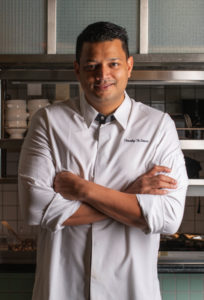
Take us through a typical day in your life.
I get up at 8am and start my day with laps in the pool every day. Then I down a glass of cold brew coffee before I ride my bicycle to work at 9.30am.
A typical day at work starts at 10am and ends at around 10pm. The first thing I do when I get to Culina at COMO Dempsey is take a walk through the Market to see what’s available. Then I’ll meet with the Head Baker Saman to check on the Bakery’s production. Next up would be a meeting with Chef Zhao where we would run through the offerings at the fishery and sample oysters. Following that, I’ll meet with the Head Butcher Vui to check the dry age cabinet and meat production.
By 10.20am, I’ll have a second round of cold brew coffee before doing a kitchen walkthrough to ensure that all the sections have everything well prepped and in place for service. At 10.45am, I’ll have my daily briefing with our Operations Manager Jean Philippe and he will conduct a front-of-house briefing. Service starts at 11am and it’s time to rock and roll!
What do you do in between service?
As Culina Bistro’s an all-day dining restaurant, we pretty much work the full 12 hours from 10am to 10pm and we have an hour break sometime between 3pm to 5pm . I like to take this chance to eat and relax a little before getting back to the grind.
Where are some of your favourite places to source for ingredients and why?
Culina sources the freshest ingredients from all over the globe. We work with some of the finest purveyors of produce and specialty foods throughout Europe and Australia, so we really do have the best from every part of the world all year round, whether it’s summer in Europe, or winter or spring in the Southern Hemisphere.
Currently, I’m loving the green asparagus from Korea, globe artichokes and Bouchot mussels from France and flounder from Australia. I’m already looking forward to the start of the Mont d’Or cheese season. I like it baked with white wine, pink peppercorns and thyme, and served with sliced boiled pork sausages and cold cuts.
What did you miss most before Phase 2 started?
As dine-in was not allowed, I really missed the interaction with people and seeing guests celebrate with food and drinks.
What inspires you?
I draw inspiration from numerous things – from the weather and sporting events, to seasonal produce and even simple things in the kitchen like a perfectly cut lemon wedge or a fresh piece of fish.
Tell us something about yourself that’s not commonly known.
I’m the youngest of 12 in my family. I have seven brothers and four sisters.
What would you be if you weren’t a chef?
I’ve always had a love for electricity and being wired. So I guess I would be a sparky electrician.
A Day in the Life of Executive Chef Yamamura Katsuhiko
Ippoh Tempura Bar by Ginza Ippoh
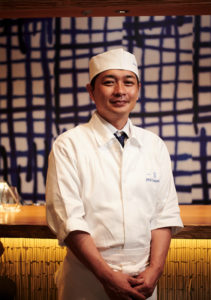
Take us through a typical day in your life.
I usually start work between 9.30am and 10am. When I arrive at the restaurant, I check the reservation status (number of guests dining) and start preparing accordingly. During prep, we’ll get deliveries from the vendors and we’ll check the quality, quantity and price of the items. Once lunch service starts, I dedicate all my efforts to frying the tempura. After lunch service, I’ll work on the daily orders, do some office work and have lunch. After taking a short break, I start dinner service from 5pm. Once that’s over, I clean up the kitchen and go home at around 10pm or 10.30pm, depending on when the customers leave.
Do you interact a lot with guests during service?
Yes, a lot of customers like to chat with me when I’m frying the tempura. They often ask what kind of oil I use – it’s prime safflower oil from Japan.
Where are some of your favourite places to source for ingredients and why?
I have a good relationship with many Japanese food suppliers, and I mainly source from Toyosu Market in Japan. My favourite place to look for ingredients is in Hokkaido, because the quality and the taste of the food there is extremely good. At our restaurant, we use fresh sea urchins and fresh scallops from Hokkaido.
What did you miss the most before Phase 2 started?
I genuinely missed having the restaurant open and meeting all our customers. Personally, I missed going to my favourite restaurant Izakaya Naniwa at Cuppage Plaza.
What do you usually cook for yourself at home?
I cook many kinds of Japanese food at home. For example, dashimaki, miso soup, oden, grilled fish and karaage.
What inspires you?
I am inspired by my friend, who is a shokunin chef – as well as other experienced shokunin chefs – to use new ingredients and techniques for cooking. A shokunin is a person who makes something by hand using honed skills, knowledge and behaviour that he or she has acquired over many years – they have a unique sensitivity to their craft. They are sometimes known as artisans.
Additionally, whenever the Master Chef Seki comes to Singapore, I am always inspired by his unique cooking technique and graceful behaviour.
Tell us something about yourself that’s not commonly known.
My grandfather and father are also chefs. Their specialty is traditional Japanese kaiseki cuisine. They’re currently based in their hometown of Shiga prefecture.
What would you be if you weren’t a chef?
If I weren’t a chef, I would have been a music engineer.
A Day in the Life of Executive Chef Melissa Revilla
The Dempsey Cookhouse and Bar
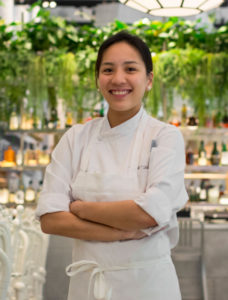
Take us through a typical day in your life.
I set my alarm for 8am, but I actually get out of bed at 8.30am. I walk and feed my dog, Logan, then I take a shower.
It may seem odd, but like most chefs I know, I’ve gotten used to not eating a full meal during the day. Once I get to work, it’s all work. I usually have time to eat during my break in the afternoon.
I get to Dempsey when my shift starts at 10am. The first thing I do is change into my chef whites. At around 10.30am, I walk through the restaurant to check up on my cooks at the stations. Then I make myself a coffee – this is one thing I can’t live without. It’s got to be a flat white, with perfectly steamed milk that’s not too hot.
I go to the office to check emails and review the Banquet Order (BO) for the day. The BO lists any special events we need to prepare for, such as big groups, special menus, dietary requirements, etc. Before starting service, I check how many reservations there are and look at my roster to make sure I have enough manpower.
At around 11.15am, I do the line check.
What happens during the line check?
I visit each station and taste all the ingredients. If anyone is struggling or lagging behind, I start diverting people to that station to help out.
We refer to the master checklist when we do line checks. The ingredients for each dish are listed here, and we check them off as we do a thorough line check.
Organisation is the name of the game for Jean-Georges. As he has many restaurants all over the world, it’s extremely important to maintain control and consistency – having a master checklist helps us achieve that.
By 11.45am, we do a briefing with the front-of-house staff and update them on items that are running low as well as some off the menu specials we have for the day.
Then at 12pm, service starts. I stay in the pass until the end of service. The pass is where all the food comes out and this is where I conduct the quality check.
After service, I continue my office work. I usually take a look at the BOs for the following days, and ensure that we order everything we need. I build menus for different parties, change menus, do up costing sheets and rosters, approve overtimes – there really is a lot of paperwork. Sometimes, this is when we have our operations meetings.
Where do you like to get your ingredients, or inspiration for them?
Travel influences my relationship with food and ingredients. I like to travel a lot as it enriches me and expands my palate. Pre-COVID, I made it a point to visit a new country each year. The last place I travelled to was the Philippines, to visit my grandmother. Before that it was Japan and Taiwan. When I travel, my main agenda is to eat! I make a list of restaurants and local markets I want to visit.
A lot of the ingredients we use here are from Culina, except for the local ingredients like chilli, lemongrass and kaffir lime. We get tomatoes, beets, strawberries and really good sweet white corn for the summer from the Cameron Highlands.
What do you normally eat at home?
My husband is French but he cooks a lot of Asian food like stir-fried pork or beef with ginger, oyster sauce, soya sauce and bok choy. He cooks porridge with ginger, cabbage and pork shoulder, which I love. I love Korean and Thai food too.
What did you miss most before Phase 2 started?
The people. It was so sad coming in for service without seeing a crowd. There was no music, no lights, no lively atmosphere. Before lockdown when things were busier, I never had a lot of time to interact with our patrons, but it felt good seeing them from the pass, really enjoying their meals and having a nice time at our restaurant. In the kitchen, I only saw five people at a time – it felt so empty.
Personally, I miss travelling. I had three important trips planned this year, but they were all cancelled. It was really unfortunate because my wedding ceremony was supposed to happen on September 8th in France!
Tell us something about yourself that’s not commonly known.
Jeanette and I laughed at my answer to this question. But seriously, I want to be a pastry chef. It’s an area that I’ve always wanted to explore but never got the chance to.
During the circuit breaker, I made a lot of bread – I suppose that’s something I miss about it. I now have a starter called Esmérelda, or Esmé for short! I had much more time to really get into bread, so I was making a lot. I made sourdough, baguette, pandesal (a Filipino bread), pretzels, doughnuts and bagels – they were all pretty good. I think ultimately, I want to have my own café after I retire.
Other than being the owner of Café Esméralda, what would you be if you weren’t a chef?
I can’t imagine myself doing anything else. I graduated with a degree in Economics and took on a corporate job for a while, but I knew in my heart that I was always meant to be a chef. Maybe if I weren’t a chef, I’d still be doing something related to food.
A Day in the Life of Head Chef Ben Woo
The Pantry
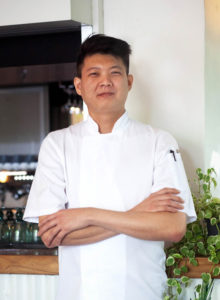
Take us through a typical day in your life.
I start my mornings with a cup of hot coffee. My first task is doing the food inventory before mise en place or preparing for breakfast service. Before service begins at 9am, we usually have a briefing with the whole team, including the kitchen staff and the front-of-house staff, to share on the daily specials and any other updates for the day. During breakfast service, we also start preparing for lunch. Once afternoon service is smooth and the lunch crowd thins, I do the stock-taking and place orders for next day’s service, before doing other paperwork such as costing, scheduling, and working on new recipes and menus.
Where are some of your favourite places to source for ingredients and why?
While we do have our usual suppliers, Culina is definitely one of my favourites. Its ingredients are always fresh and it has a lot of rare and unique ingredients that are specially imported from overseas.
What did you miss most before Phase 2 started?
During lockdown, I honestly missed the usual routine of being busy in the kitchen. But I was so grateful for the opportunity to be involved in the Food Bank initiative where we prepared over a hundred meals a week for the less fortunate. I was happy to have the chance to contribute to society, especially for those in need, with my cooking. I also got to design a new family meal menu – which focused on the concept of families eating together at home – for takeaway and delivery.
Outside of work, I definitely missed my hometown Yong Peng in Malaysia. I missed seeing my family, friends and the food! Especially this thick and flavourful soya noodles called Hock Chew Noodles, black vinegar noodles, Yong Peng Duck Noodle, traditional Yong Peng Bread, which is usually sweet or with sesame, thick Hock Chew Egg Gravy Soup, and Saury Fish Balls.
What do you do on your days off?
On my days off, I enjoy watching Hong Kong dramas, TV shows and movies. I recently watched Fast and Furious and loved it!
What inspires you?
I have always liked to cook. I also enjoy reading cookbooks and watching cooking shows by Gordon Ramsay like MasterChef or Hell’s Kitchen, because of how nerve-wrecking and exciting it gets. Whenever I come across an interesting recipe, I have to try it.
What is the most recent new recipe you’ve tried?
The Halloween menu. I’ve tried out a few recipes and will be going ahead with a lovely roasted pumpkin and beetroot salad, and a ribeye steak with charcoal mashed potato. Feel free to come by The Pantry during Halloween for a try!
What would you be if you weren’t a chef?
I am an absolute foodie. As food is such an essential part of my identity and personality, I can’t imagine myself without it, so I’d definitely still be doing something food-related.


